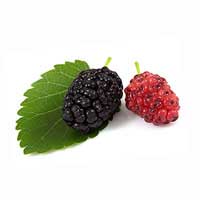Fruits Home
 Full List of Fruits
Full List of Fruits  Black Mulberry
Black MulberryBlack Mulberry fruit
![]() Introduction of Black Mulberry
Introduction of Black Mulberry
Scientific name - Morus nigra
Native to western Asia, mulberries has a royal association that dates back to Tudor times. It is dark purple in color i.e. almost black. Notorious for having large number of chromosomes, they are extremely juicy and have a refreshing, sub acid, saccharine taste. It is usually said that the oldest Mulberry tree fruits are best.
![]() Nutritional Value of Black Mulberry
Nutritional Value of Black Mulberry
| Energy | 180 kJ (43 kcal) |
| Carbohydrates | 9.8 g |
| Sugars | 8.1 |
| Dietary fiber | 1.7 g |
| Fat | 0.39 g |
| Protein | 1.44 g |
| Vitamins | |
| Thiamine (B1) | (3%) 0.029 mg |
| Riboflavin (B2) | (8%) 0.101 mg |
| Niacin (B3) | (4%) 0.62 mg |
| Vitamin B6 | (4%) 0.05 mg |
| Folate (B9) | (2%) 6 µg |
| Choline | (3%) 12.3 mg |
| Vitamin C | (44%) 36.4 mg |
| Trace metals | |
| Calcium | (4%) 39 mg | Iron | (14%) 1.85 mg |
| Magnesium | (5%) 18 mg |
| Phosphorus | (5%) 38 mg |
| Potassium | (4%) 194 mg |
| Sodium | (1%) 10 mg |
| Zinc | (1%) 0.12 mg |
![]() Health Benefits of Black Mulberry
Health Benefits of Black Mulberry
The black mulberry has numerous health benefits. Rich in Vitamin C, this fruit is especially used to treat colds. Influenza, nose bleeds and eye infections are usually treated by consuming the leaves internally. Cold is also treated using the leaves. A tincture of the bark of the tree is used to treat toothaches. The fruit is also used to treat premature graying of hair, constipation among the elderly, tinnitus and urinary incontinence. Among herbal medicines, it is commonly used as a coloring and flavoring agent. A homeopathic medicine for the treatment of diabetes is made from the leaves of this berry. The bark and the root bark also play a huge role in remedies. The bark is anthelmintic and purgative used to expel tape worms. The root bark is antitussive, diuretic and hypertensive. It is mostly used to treat hypertension, asthma and coughs.
Mulberries like most berries require soil that has great water retention capacity, well drained and deep. Plant them at the right time with healthy roots, and beautiful trees will emerge. Mulberries prefer a warm soil and hence the spring is the right time for planting those roots. Roots that have been grown bare will usually establish well, but container grown plants will usually have circled roots which may not establish well. A partly trained plant will establish best and grow in to a beautiful and firm tree.
The mulberry tree required about 5 to 10m of space to establish its spreading habit. Sow the fruits as soon as the seeds ripen otherwise in February. It should usually germinate in spring and will take another twelve months to actually come out. The seeds should be pricked into individual pots that can handle the trees. It is also recommended to grow in a cold frame for their first winter. A late spring or early summer planting is highly recommended.
A cutting of half ripe wood is said not to survive but mature wood is said to flourish otherwise. Cut in February, cuttings are placed 30cm deep in shady and sheltered positions. The stem is covered in moss to prevent water loss.
Cuttings: Cuttings are one of the most common methods of propagating black mulberry. Cuttings can be taken from both young and mature trees and should be taken in the late summer or early fall. Choose stem cuttings that are 4 to 6 inches long with several leaves at the top. Remove the lower leaves and dip the cut end of the cutting in rooting hormone. Plant the cutting in a pot filled with moist potting soil and keep the soil moist until the cutting has rooted.
Layering: Layering is another popular method of propagating black mulberry. To do this, choose a mature branch on the tree and bend it to the ground. Make a few shallow slits in the bark near the bend and cover the area with moist soil. The branch will eventually form roots and can be cut away from the parent plant and transplanted elsewhere.
Seeds: Propagating black mulberry from seed is a slower process than the other methods. Collect ripe mulberry fruits in the late summer and remove the seeds. Place the seeds in a bucket of water and discard any seeds that float. Soak the remaining seeds in warm water for 24 hours. Plant the seeds in pots filled with moist potting soil and keep the soil moist until the seeds germinate.
Grafting:
Grafting is an advanced method of propagating black mulberry. It involves attaching a bud or scion from another tree onto a rootstock. This can be done in either the spring or fall. It is important to choose compatible scions and rootstocks and to use sharp, clean tools when grafting. Once the graft is made, the rootstock must be kept well-watered and protected from extreme temperatures.
In conclusion, black mulberry can be successfully propagated by a variety of methods, including cuttings, layering, seeds, and grafting. Each method has its own advantages and disadvantages, so it is important to choose the right method based on the particular needs of the tree. Proper care and maintenance throughout the propagation process is essential for successful results
Black Mulberry is most commonly used for its fruit, which can be eaten fresh or made into jams, jellies, and juices. The leaves are also edible and can be boiled and eaten as a vegetable. The fruit is a good source of vitamins A and C, as well as other minerals. The bark of the black mulberry tree has been used medicinally for centuries. It can be used to treat several ailments such as diarrhea, fever, and asthma. It is also believed to have anti-inflammatory and anti-bacterial properties.
The bark can be made into a tea or extract that can be taken orally to treat these ailments. In addition to its medicinal uses, the black mulberry tree has also been used for its wood. The wood is strong yet lightweight and is often used in the construction of furniture and boats. The wood is also used to make paper and can be used as a fuel. The black mulberry tree is also popular for its ornamental uses. The tree has attractive foliage and fragrant flowers that bloom in the spring. The fruit is also attractive to birds and other wildlife. The tree is popular for landscaping and can be used as a shade tree or a windbreak.


















